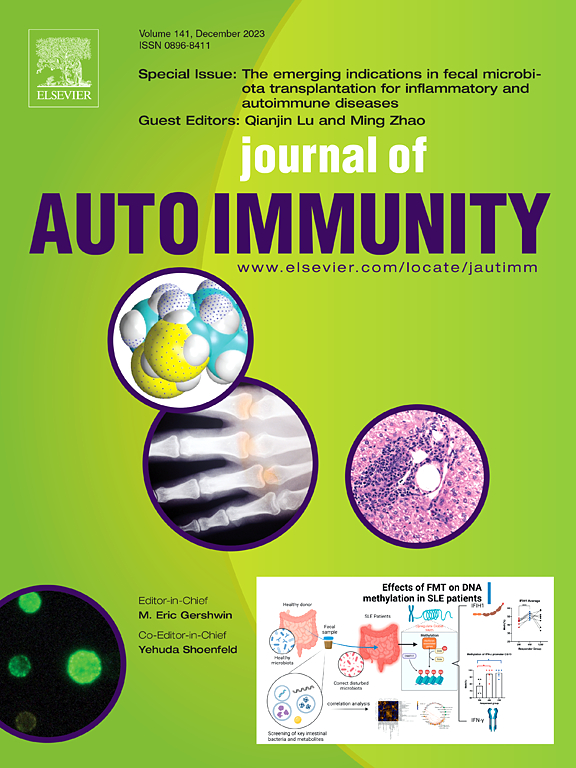Primary Cesarean delivery and future risk of maternal autoimmune disease: A population-based cohort study
IF 7
1区 医学
Q1 IMMUNOLOGY
引用次数: 0
Abstract
Objectives
To determine the association between primary Cesarean delivery and incident autoimmune disease in women.
Methods
We conducted a population-based cohort study of 253,901 females in Ontario, Canada with a first childbirth between 2012 and 2017 and with no pre-existing autoimmune disease. Royston-Parmar models were used to estimate the time-varying association between Cesarean delivery (28.2 % of females) versus vaginal delivery (71.8 % of females; referent) and celiac disease, multiple sclerosis (MS), rheumatoid arthritis (RA), and systemic autoimmune rheumatic disease (SARD), separately, from date of delivery to date of diagnosis or censoring at death, loss of health insurance, or March 31, 2021. To account for potential confounding by indication for Cesarean delivery, models were generated using (i) overlap weighting based on propensity scores for mode of delivery and (ii) with restriction to low-risk pregnancies free of pre-labour Cesarean indications (n = 146,887).
Results
At up to 9 years following childbirth (median = 6.5 years of follow-up), Cesarean delivery was associated with an increased risk of MS, but not celiac disease, RA, or SARD. Overall, cumulative incidence of MS was 0.28 % following Cesarean delivery and 0.21 % following vaginal delivery. After overlap weighting, the adjusted hazard ratio (AHR) curve formed a slight L-shape with the largest magnitude between birth and 3 years (1-year AHR 1.37, 95 % CI 1.04–1.69) and diminishing thereafter (5-year 1.23, 95 % CI 0.91–1.55; 7-year 1.21, 95 % CI 0.84–1.57). Results were similar when restricted to births following low-risk pregnancies.
Conclusions
Findings suggest a possible link between Cesarean delivery and MS development among females that warrants future replication and explanatory studies.
原发性剖宫产与母体自身免疫性疾病的未来风险:一项基于人群的队列研究
目的:探讨女性原发性剖宫产与自身免疫性疾病的关系。方法:我们对加拿大安大略省的253,901名女性进行了一项基于人群的队列研究,这些女性在2012年至2017年期间首次分娩,并且没有预先存在的自身免疫性疾病。使用Royston-Parmar模型来估计剖宫产(28.2%的女性)与阴道分娩(71.8%的女性)之间的时间变化相关性;(参考文献)和乳糜泻、多发性硬化症(MS)、类风湿性关节炎(RA)和系统性自身免疫性风湿病(SARD),分别从分娩之日到死亡、失去健康保险时的诊断或检查之日,或2021年3月31日。为了解释剖宫产指征的潜在混淆,模型使用(i)基于分娩方式倾向得分的重叠加权和(ii)限制无产前剖宫产指征的低风险妊娠(n = 146,887)生成。结果:在分娩后长达9年(中位随访6.5年),剖宫产与MS的风险增加相关,但与乳糜泻、RA或SARD无关。总的来说,剖宫产后MS的累积发病率为0.28%,阴道分娩后MS的累积发病率为0.21%。重叠加权后,调整后的AHR曲线呈轻微的l型,出生至3岁最大(1年AHR 1.37, 95% CI 1.04 ~ 1.69),此后逐渐减小(5年1.23,95% CI 0.91 ~ 1.55;7年1.21,95% CI 0.84-1.57)。当仅限于低风险妊娠后的分娩时,结果相似。结论:研究结果提示剖宫产与女性多发性硬化症发展之间可能存在联系,值得进一步的复制和解释性研究。
本文章由计算机程序翻译,如有差异,请以英文原文为准。
求助全文
约1分钟内获得全文
求助全文
来源期刊

Journal of autoimmunity
医学-免疫学
CiteScore
27.90
自引率
1.60%
发文量
117
审稿时长
17 days
期刊介绍:
The Journal of Autoimmunity serves as the primary publication for research on various facets of autoimmunity. These include topics such as the mechanism of self-recognition, regulation of autoimmune responses, experimental autoimmune diseases, diagnostic tests for autoantibodies, as well as the epidemiology, pathophysiology, and treatment of autoimmune diseases. While the journal covers a wide range of subjects, it emphasizes papers exploring the genetic, molecular biology, and cellular aspects of the field.
The Journal of Translational Autoimmunity, on the other hand, is a subsidiary journal of the Journal of Autoimmunity. It focuses specifically on translating scientific discoveries in autoimmunity into clinical applications and practical solutions. By highlighting research that bridges the gap between basic science and clinical practice, the Journal of Translational Autoimmunity aims to advance the understanding and treatment of autoimmune diseases.
 求助内容:
求助内容: 应助结果提醒方式:
应助结果提醒方式:


